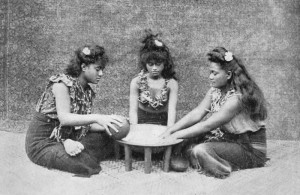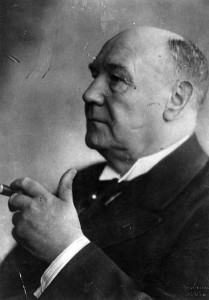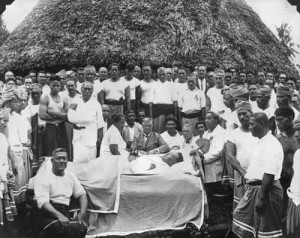Samoa
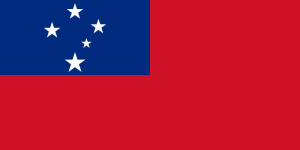
Samoa (1949)
Western Samoa, Lotus Land of the Pacific, is administered by New Zealand under United Nations trusteeship. The Administration brings to the Samoans those European services which will benefit them, and aids them in preserving all the best of their own ways of living. With modern amenities at hand, Samoan life goes on much as it has always done in the thatched villages amid the groves. The slim canoes still glide in from the fishing grounds, the food is cooked in ovens of heated stones, and the flower-decked girls sing and dance beneath the palms. B&W 17 mins. 35mm 1,550 ft. SAMOA Produced by N.Z. National Film Unit MADE WITH THE COOPERATION OF THE PEOPLE OF WESTERN SAMOA. BACKGROUND SONGS BY THE OLOMENI AUFAIPESE. Producer STANHOPE ANDREWS Direction.. STANHOPE ANDREWS Camera… IVO TISCH Sound…. ROBERT ALLEN Supervision Technical GEOFFREY SCOTT Production CYRIL MORTON PROCESSING BY NATIONAL FILM UNIT LABORATORY. DV file from BetaSP telecini of a 35mm print.
(![]() i/səˈmoʊ.ə/; Samoan: Sāmoa, IPA: [ˌsaːˈmoa]), officially the Independent State of Samoa (Samoan: Malo Sa’oloto Tuto’atasi o Sāmoa), formerly known as Western Samoa, is a country encompassing the western part of the Samoan Islands in the South Pacific Ocean. It became independent from New Zealand in 1962. The two main islands of Samoa are Upolu and one of the biggest islands in Polynesia,Savai’i. The capital city, Apia, and Faleolo International Airport are situated on the island of Upolu. Samoa was admitted to the United Nations on 15 December 1976. The entire island group, inclusive of American Samoa, was called “Navigator Islands” by European explorers before the 20th century because of the Samoans’ seafaring skills.
i/səˈmoʊ.ə/; Samoan: Sāmoa, IPA: [ˌsaːˈmoa]), officially the Independent State of Samoa (Samoan: Malo Sa’oloto Tuto’atasi o Sāmoa), formerly known as Western Samoa, is a country encompassing the western part of the Samoan Islands in the South Pacific Ocean. It became independent from New Zealand in 1962. The two main islands of Samoa are Upolu and one of the biggest islands in Polynesia,Savai’i. The capital city, Apia, and Faleolo International Airport are situated on the island of Upolu. Samoa was admitted to the United Nations on 15 December 1976. The entire island group, inclusive of American Samoa, was called “Navigator Islands” by European explorers before the 20th century because of the Samoans’ seafaring skills.
The oldest date so far from pre-historic remains in Samoa has been calculated by New Zealand scientists to a likely true age of circa 3,000 years ago from a Lapita site at Mulifanua during the 1970’s. The origins of the Samoans are closely studied in modern research about Polynesia in various scientific disciplines such as genetics, linguistics and anthropology. Scientific research is ongoing although a number of different theories exist; including one proposing that the Samoans originated from Austronesian predecessors during the terminal eastward Lapita expansion period from Southeast Asia and Melanesia between 2,500 and 1,500 BCE. The Samoan origins are currently being reassessed due to new scientific evidence and carbon dating findings from 2003 and onwards. Intimate sociocultural and genetic ties were maintained between the eastern Lapita colonies and the archaeological record supports oral tradition and native genealogies that indicate inter-island voyaging and intermarriage between prehistoric Samoans, Fijians, and Tongans.
Studio photo depicting preparation of the Samoa ‘ava ceremony c. 1911.
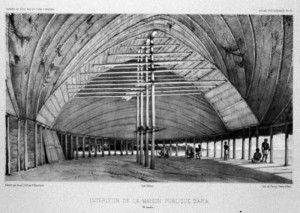 Interior of Samoan house, Apia, Urville 1842. Contact with Europeans began in the early 18th century. Jacob Roggeveen (1659–1729), a Dutchman, was the first known European to sight the Samoan islands in 1722. This visit was followed by French explorer Louis-Antoine de Bougainville (1729–1811), who named them the Navigator Islands in 1768. Contact was limited before the 1830s which is when English missionaries and traders began arriving. Mission work in Samoa had begun in late 1830 by John Williams, of the London Missionary Society arriving in Sapapali’i from The Cook Islands and Tahiti. According to Barbara A. West, “The Samoans were also known to engage in ‘headhunting,’ a ritual of war in which a warrior took the head of his slain opponent to give to his leader, thus proving his bravery.” There is recorded history of an event which took place when two German lives were taken and then their corpses beheaded by a citizen during that nation’s administration of Samoa. A return attempt between two Samoans led to similar beheading although the practice was known not to be condoned amongst Samoans. The event precedes the short time before further tripartite conflict for the territories. Robert Louis Stevenson, the author who lived in Samoa from 1889 wrote in his recordings of the period 1882–1892 A Footnote to History: Eight Years of Trouble in Samoa, “The Samoans are gentle people.”
Interior of Samoan house, Apia, Urville 1842. Contact with Europeans began in the early 18th century. Jacob Roggeveen (1659–1729), a Dutchman, was the first known European to sight the Samoan islands in 1722. This visit was followed by French explorer Louis-Antoine de Bougainville (1729–1811), who named them the Navigator Islands in 1768. Contact was limited before the 1830s which is when English missionaries and traders began arriving. Mission work in Samoa had begun in late 1830 by John Williams, of the London Missionary Society arriving in Sapapali’i from The Cook Islands and Tahiti. According to Barbara A. West, “The Samoans were also known to engage in ‘headhunting,’ a ritual of war in which a warrior took the head of his slain opponent to give to his leader, thus proving his bravery.” There is recorded history of an event which took place when two German lives were taken and then their corpses beheaded by a citizen during that nation’s administration of Samoa. A return attempt between two Samoans led to similar beheading although the practice was known not to be condoned amongst Samoans. The event precedes the short time before further tripartite conflict for the territories. Robert Louis Stevenson, the author who lived in Samoa from 1889 wrote in his recordings of the period 1882–1892 A Footnote to History: Eight Years of Trouble in Samoa, “The Samoans are gentle people.”
Wilhelm Solf, German governor of Samoa 1900–1910
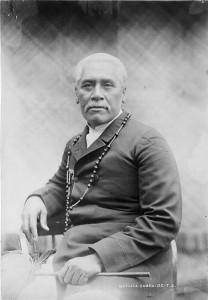 Mata’afa Iosefo (1832–1912) paramount chief & rival for the kingship of Samoa
Mata’afa Iosefo (1832–1912) paramount chief & rival for the kingship of Samoa
The Germans in particular began to show great commercial interest in the Samoan Islands, especially on the island of ‘Upolu where German firms monopolised copra and cocoa bean processing; the United States laid its own claim and formed alliances with local native chieftains, most conspicuously on the islands of Tutuila and Manu’a (which were later formally annexed to the USA as American Samoa). Britain also sent troops to protect British business enterprise, harbour rights, and consulate office. There followed an eight-year civil war, where each of the three powers supplied arms, training, and in some cases, combat troops to the warring Samoan parties. The Samoan crisis came to a critical juncture in March 1889 when all three colonial contenders sent warships into Apia harbour, and a larger-scale war seemed imminent, until a massive storm on 15 March 1889 damaged or destroyed the warships, ending the military conflict. The Second Samoan Civil War was a conflict that reached a head in 1898 when Germany, the United Kingdom, and the United States were locked in dispute over who should have control over the Samoa Islands. The Siege of Apia occurred during the Second Samoan Civil War in March 1899 at Apia. Samoan forces loyal to Prince Tanu were besieged by a larger force of Samoan rebels loyal to Mata’afa Iosefo. Supporting Prince Tanu were landing parties from four British and American warships. Over the course of several days of fighting, the Samoan rebels were defeated. American and British warships shelled Apia on 15 March 1899; including the USS Philadelphia. Germany, the United Kingdom and the United States quickly resolved to end the hostilities; with the partitioning of the island chain at the Tripartite Conventionof 1899.
20th Century
The Tripartite Convention of 1899 partitioned the Samoan Islands into two parts: the eastern island group became a territory of the United States (the Tutuila Islands in 1900 and officially Manu’a in 1904) and is today known as American Samoa; the western islands, by far the greater landmass, became known as German Samoa after Britain vacated all claims to Samoa and accepted termination of German rights in Tonga and certain areas in the Solomon Islands and West Africa. The Germans ruled Western Samoa from 1900 to 1914, although the German government under “Prince Bismarck” announced Samoa’s “annexation” as early as 1885. In 1908, the Samoan people formed the non-violent MAU A PULE resistance movement. In 1909 its leader, Lauaki Namulauulu Mamoe, was deported to Saipan in the Mariana islands by the German government. By 1912 the German administration, preparing for war in Europe, maintained a semblance of local participation in government, which they had been studying, in order to dominate it, in colonial fashion. There was no more Tupu (King), nor even alii sili (similar to a governor), but the two Fautua (Advisors) were appointed. Tumua and Pule (traditional governments of Upolu and Savaii) were for a time silent; all decisions on matters affecting lands and titles were under the control of the Governor. To complete the process, the Fa’alupega for all Samoa was revised. In a culture based on oratory, the Fa’alupega is a formal greeting which acknowledges those being greeted and their status. The Fa’alupega, which had been nationally accepted from at least the late 19th century (and probably for much longer than that), was as follows:
“Tulouna a Tumua ma Pule,
Tulouna a Itu’au ma Alataua,
Tulouna a Aiga-i-le-Tai,
Ma le Va’a-o-Fonoti,
Tulouna a Tama ma a latou aiga
Po’o aiga ma a latou tama.”
This firstly recognised the authority and identity of principal districts of Samoa through their spokesmen – Tumua ma Pule, Itu’au ma Alataua, Aiga-i-le-Tai, and the Va’a-o-Fonoti – and the highest titles which were bestowed by these groups. It concludes with the recognition of the great maximal descent groups of Samoa and their “sons” who had been chosen to hold the highest titles. The new Fa’alupega of German Samoa, which in its first line recognises the Kaiser (Kaisa), apparently required Malietoa Tanumafili and Tupua Tamasese to be sworn on oath to become advisors to the governing council:
“Tulouna a lana Maiesitete le Kaisa o le tupu mamalu o lo tatou malo kasialika aoao.
Tulouna a lana afioga le kovana kasialika o le sui o le kaisa I Samoa nei.
Susu mai Malietoa, Afio mai Tupua
Ua fa’amanatuiana ai aiga e lua I o oulua tofiga Kasialika o le Fautua.
Tulouna a le vasega a Faipule Kasialika o e lagolago malosi I le Malo.
Afifio mai le nofo a vasega o tofiga Kasialika o e usu fita I le tautua I le malo.”
The first German Governor, Wilhelm Solf, later went on to become Secretary for the Colonies of Imperial Germany. New Zealand troops landed on ‘Upolu unopposed on 29 August 1914 and seized control from the German authorities, following a request by Britain for New Zealand to perform their “great and urgent imperial service.”
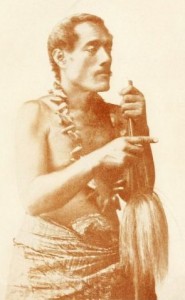 Exiled orator Lauaki Namulauulu Mamoe New Zealand rule 1914-1962
Exiled orator Lauaki Namulauulu Mamoe New Zealand rule 1914-1962
From the end of World War I until 1962, New Zealand controlled Samoa as a Class C Mandate under trusteeship through the League of Nations, then through the United Nations. There followed a series of New Zealand administrators who were responsible for two major incidents. In the first incident, approximately one fifth of the Samoan population died in the influenza epidemic of 1918–1919. In 1919 The Royal Commission of Inquiry into the Epidemic concluded that there had been no epidemic of pneumonic influenza in Western Samoa before the arrival of the SS Talune from Auckland on 7 November 1918. The NZ administration allowed the ship to berth in breach of quarantine; within seven days of this ship’s arrival influenza became epidemic in Upolu and then spread rapidly throughout the rest of the territory.
People in attendance at Tupua Tamesese’s funeral.
The second major incident arose out of an initially peaceful protest by the Mau (which literally translates as “strongly held opinion”), a non-violent popular movement which had its beginnings in the early 1900s on Savai’i, led by Lauaki Namulauulu Mamoe, an orator chief deposed by Solf. In 1909, Lauaki was exiled to Saipan and died en route back to Samoa in 1915. By 1918, Samoa had population of some 38,000 Samoans and 1,500 Europeans. However Samoans greatly resented New Zealand’s imperialism, and blamed inflation and the catastrophic 1918 flu epidemic on its misrule. By the late 1920’s the resistance movement against colonial rule had gathered widespread support during the mistreatment of the Samoan people by the New Zealand administration. One of the Mau leaders was Olaf Frederick Nelson, a half Samoan and half Swedish merchant. Nelson was eventually exiled during the late 1920s and early 1930’s, but he continued to assist the organisation financially and politically. In accordance with the Mau’s non-violent philosophy, the newly elected leader, High Chief Tupua Tamasese Lealofi, led his fellow uniformed Mau in a peaceful demonstration in downtown Apia on 28 December 1929. The New Zealand police attempted to arrest one of the leaders in the demonstration. When he resisted, a struggle developed between the police and the Mau. The officers began to fire randomly into the crowd and a Lewis machine gun, mounted in preparation for this demonstration, was used to disperse the demonstrators. Chief Tamasese was shot from behind and killed while trying to bring calm and order to the Mau demonstrators, screaming “Peace, Samoa.” Ten others died that day and approximately 50 were injured by gunshot wounds and police batons. That day would come to be known in Samoa as Black Saturday. The Mau grew, remaining steadfastly non-violent, and expanded to include a highly influential women’s branch.
Independence 1962
After repeated efforts by the Samoan people, Western Samoa gained independence in 1962 and signed a Friendship Treaty with New Zealand. Samoa, the first small-island country in the Pacific to become independent, joined the Commonwealth of Nations on 28 August 1970. In 2002, New Zealand’s prime minister Helen Clark, on a trip to Samoa, formally apologised for New Zealand’s role in the events of 1918 and 1929. In July 1997 the government amended the constitution to change the country’s name from Western Samoa to Samoa. The US territory of American Samoa protested the move, asserting that the change diminished its own identity. As of 2012 American Samoans still use the terms Western Samoa and Western Samoans to describe the independent State of Samoa and its inhabitants. Travel writer Paul Theroux noted marked differences between the societies in Samoa and American Samoa.
21st Century
On 7 September 2009, the government changed the driving orientation for motorists and Samoans now drive on the left hand side of the road. This brings Samoa into line with many other countries in the region. Samoa is the first country in recent years, and the first in the 21st century, to switch to driving on the left. At the end of December 2011, Samoa jumped forward by one day, omitting 30 December from the local calendar, when the nation moved to the west of the International Date Line. This was designed to help the nation boost its economy by doing business with Australia and New Zealand. Before this change, Samoa was 21 hours behind Sydney, but the change means it is now three hours ahead. The previous timezone was agreed on 4 July 1892, to work in line with American traders based in California.


